
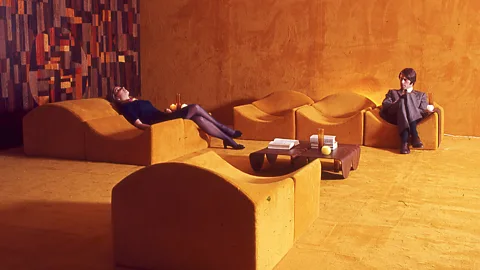 Ligne Roset/ Area Age Design by Peter Martin/ teNeues
Ligne Roset/ Area Age Design by Peter Martin/ teNeuesArea-age model is skyrocketing in popular culture – in celebrities’ properties, at world design festivals and even in blockbuster movies. We glance again on the beautiful retro-futuristic origins of 2025’s largest interiors aesthetic, and ask, why now?
From aerodynamic vehicles to voluminous moonscape-style seating, common tradition and design goes cosmic. Some architects, designers, film-makers and galleries are wanting, if to not Star Wars’ “galaxy far, far-off”, then not less than past the Earth’s environment for his or her inspiration.
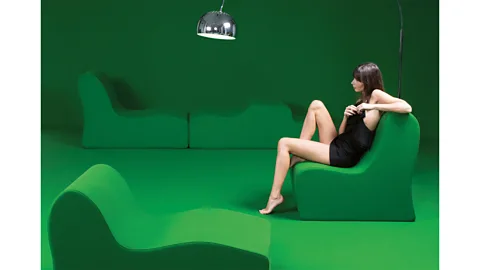 Mattia Tonelli/ Paradisoterrestre/ Area Age Design by Peter Martin/ teNeues
Mattia Tonelli/ Paradisoterrestre/ Area Age Design by Peter Martin/ teNeuesPopping out in July, Marvel Studios’ newest movie, The Fantastic Four: First Steps, boasts a front room with a round sunken couch association and shiny white round aspect tables, and vehicles with outsized fins. Not your typical styling for an action-adventure blockbuster.
Down right here in the true world, some main US inside designers have made the space-age aesthetic extremely trendy. LA- and Milan-based Giampiero Tagliaferri is among the many designers who espouses a “California Area Age” aesthetic for the properties of tech moguls, artwork collectors, trend creatives and pop stars. One such has a shiny white futuristic spiral staircase that would not have been misplaced in Stanley Kubrick’s 1968 movie, 2001: A Area Odyssey.
And US inside designer Kelly Wearstler’s personal Malibu beach house is filled with space-age design, just like the Seventies couch and chaise longue by Afra and Tobia Scarpa, and the 1957 Digamma chair with its 4 splayed toes by Ignazio Gardella.
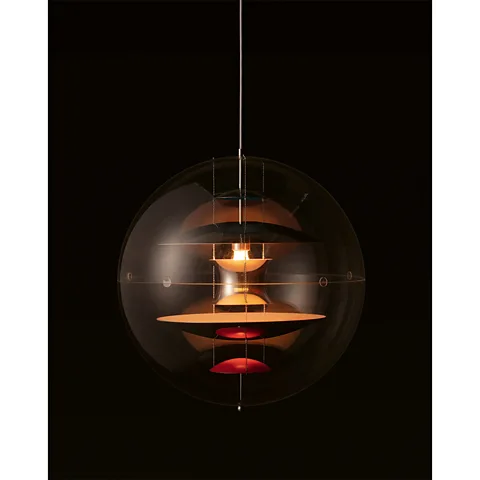 Joe Kramm/ Area Age Design by Peter Martin/ te Neues
Joe Kramm/ Area Age Design by Peter Martin/ te NeuesIn the meantime, furnishings manufacturers like Paulin, Paulin, Paulin have been fast to identify a development, or maybe are main it. The household enterprise is reissuing space-age designs from the early Seventies by influential French furnishings designer Pierre Paulin. Specifically, his Dune Ensemble modular seating arrangement with its echoes of a planetary floor has change into a favorite amongst music-industry varieties and influencers. Famously personal singer Frank Ocean, Pink Scorching Chili Peppers bassist Flea, rapper Travis Scott, Justin Bieber and Kim Kardashian are all reported to have one.
Galleries and design festivals are selecting up on this retro-futuristic nostalgia. On present at Vitra Design Museum in Germany’s Weil am Rhein is Science Fiction Design: From Area Age to Metaverse. It explores how the designers of the Area Age equipped movie administrators with the best furnishings for his or her science fiction motion pictures: Olivier Mourgue’s Sixties Djinn seating collection in 2001: A Area Odyssey; Eero Aarnio’s 1971 Tomato Chair in Barry Sonnenfeld’s Males in Black (1997); and Paulin’s 1966 Ribbon Chair in Denis Villeneuve’s Blade Runner 2049 (2017).
At this spring’s Milan Design Week, the most popular ticket was for the set up created by trend home Loro Piana and the achingly cool furnishings designers Dimorestudio. In La Prima Notte di Quiete, they offered a type of idealised cinematic Seventies condominium which was pure Italo-Californian space-age chic: sunken dialog pits, spherical beds, cascades of cuboid wall-lights, retro seating, electrical inexperienced carpet.
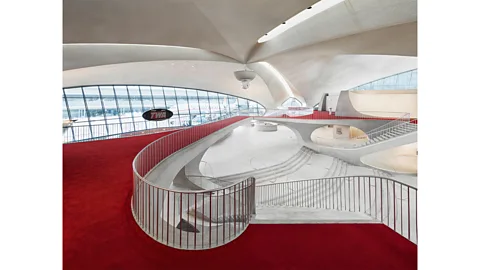 TWA Lodge
TWA LodgeArea-age styling was additionally on show at Brussels’ huge Brafa Artwork Truthful. Every year, Delen Non-public Financial institution, which has a rare assortment of Modernist artwork and mid-century furnishings, creates a collection of rooms on the truthful as the final word condominium. This time, its sassiest room was pure house age – crimson gloss partitions redolent of Verner Panton’s Visiona exhibitions, with that almost all space-age of symbols: the Joe Colombo Elda Chair.
The origins of space-age model
This aesthetic has its roots, in fact, within the first house race, which set off when the Soviets launched the Sputnik satellite tv for pc in 1957, and continued all through the Sixties with Nasa’s Apollo programme. These occasions dominated the worldwide media, and folks the world over uncynically embraced the concept humanity had entered a brand new period. “It appeared solely pure that objects and areas ought to replicate this,” Peter Martin, writer of Space Age Design: Icons of the Movement, tells the BBC.
With that backdrop, pre-war design and structure immediately regarded old-fashioned. As an alternative, the peak of cool was the forward-looking sophistication of Eero Aarnio’s 1963 Pallo or Ball Chair, ideally positioned inside a modernist dwelling.
And it wasn’t simply furnishings that leant into this space-age fever. Vehicles grew large tailfins and airports started to resemble spaceships, like Eero Saarinen’s TWA Flight Middle in New York.
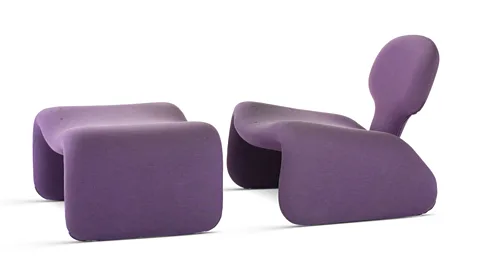 Vitra Design Museum/ Jurgen Hans/ VG Bild-Kunst Bonn 2024
Vitra Design Museum/ Jurgen Hans/ VG Bild-Kunst Bonn 2024The development accelerated with the moon touchdown on the finish of the Sixties, and was mirrored in TV and cinema. In addition to 2001: A Area Odyssey, there was the enduring TV collection Star Trek. In music, there was the Telstar single by the Tornadoes, and in trend, a number of designers unveiled futuristic looks, together with Paco Rabanne’s iconic 1968 gold-chain Area Age gown.
There was additionally a sensible purpose for space-age design’s recognition. It arrived with the appearance of newly out there supplies, which had been developed within the conflict years and by the mid-Nineteen Fifties have been discovering their means into the workshops and studios of a brand new era of designers.
For some time, plastic turned synonymous with what we now consider as space-age designers. As Cristina Bargna, head of the Plastic Design Assortment at Design Museum Brussels says in Martin’s e-book, “Within the Nineteen Fifties, plastic represented potentialities, freedom, and pleasure. The liberty of form; the likelihood to create new furnishings, to furnish new homes – a fabric that spoke to a brand new era with the need to reside in a different way. Plastic was now not a fabric that imitated what had come earlier than. It began to embody the longer term; it created a totally new imaginative and prescient of actuality.”
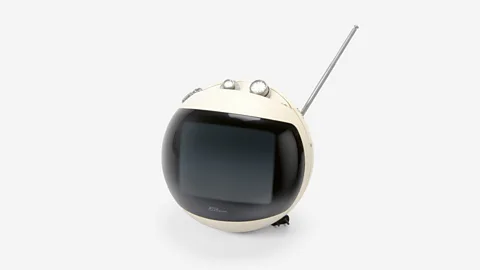 Design Museum Brussels
Design Museum BrusselsThe opposite issue was mass manufacturing, which exploded in the course of the conflict years for munitions, after which pivoted afterwards in direction of the burgeoning client tradition. Savvy designers allied themselves with producers. “The story of space-age design is in some ways a narrative of partnership between designers and producers. Joe Colombo with Kartell; Eero Saarinen with Knoll; Verner Panton with Vitra; Peter Ghyczy with Elastogran,” Martin writes in Area Age Design.
The height of space-age design was within the fast aftermath of the moon landings. “We all know now that what regarded like the beginning of issues was in actuality the tip of issues – we would quickly go away the moon and never return,” Martin says, “However within the euphoria of the moon landings, issues couldn’t have regarded extra completely different.”
At this level, house was the most popular matter, and world mainstream curiosity injected a large shot of vitality into space-age design and affect. It was seen in every single place, from David Bowie’s Area Oddity – launched a month after the touchdown – to JVC’s space-helmeted Videosphere tv.
And at a time when it appeared cheap to imagine that we would be dwelling in house inside a number of many years, designers thought of how that may look.
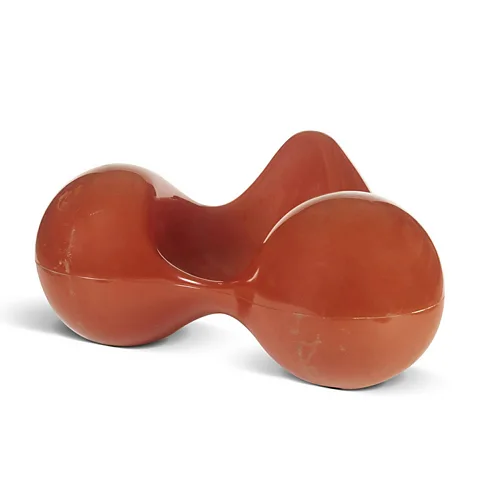 Vitra Design Museum/ Roland Engerisser
Vitra Design Museum/ Roland EngerisserCouch design is a basic instance. “Modular sofas had been round for the reason that Forties, however now they turned sprawling and heroic, made for fabulous, futuristic existence,” Martin says. Inflexible kinds have been out; enveloping, sensual, natural shapes have been in. These have been assertion sofas that would belong in a Lake Como villa or on an area station orbiting the moon. Sitting upright was out; sofas have been for slumbering, socialising or partying.
Out of this period got here two giants that may be claimed for the space-age design motion: the iconic 1973 Togo designed by Michel Ducaroy for Ligne Roset; and the 1972 Camaleonda by Mario Bellini for B&B Italia. Each are nonetheless in manufacturing and stay extraordinarily wanted.
And now the aesthetic is again. A way of rediscovery, a healthy dose of nostalgia and a brand new sense of competitors are all contributing to the revival of space-age design.
Nostalgia for the house race itself was kicked off in 2022, when Buzz Aldrin’s Apollo 11 jacket offered for $2.8m (£2.3m) at Sotheby’s in New York. Since then, house memorabilia has change into an enormous market. And final yr, Tom Hanks’ immersive present The Moonwalkers – recreating the Apollo mission – was the principle attraction at London’s Lightroom.
“That is largely due to what that period represents – the pioneering sensibility of western nations that embraced the longer term with a way of mission, ” Martin says.
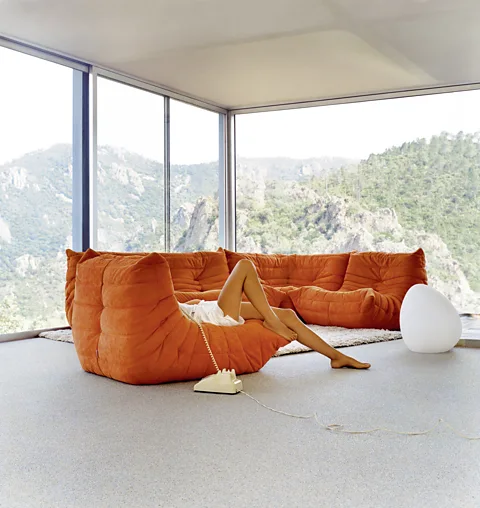 Ligne Roset/ Area Age Design by Peter Martin/ te Neues
Ligne Roset/ Area Age Design by Peter Martin/ te NeuesFeeding into this curiosity within the first house age is the truth that we at the moment are on the cusp of the second. Nasa’s Artemis programme is about to return to the moon, with people slated to land in 2027 for the primary time for the reason that Seventies. This time, the race is worldwide, with China, India and personal US firms competing for house primacy.
That is manifesting in vibrant design from a number of areas, such because the work of Chinese language-born Peng Zheng (now senior product designer at Zoom in California) and Eason Zhu (founding father of Hangzhou’s multidisciplinary design studio Fununit Design & Extra).
Designers like these, says Martin, are “making a imaginative and prescient of latest methods of dwelling which can be completely unhindered by the bags of what went earlier than”.





